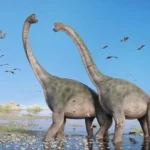Long-necked dinosaurs, or sauropods, are among the most iconic and awe-inspiring creatures to have ever lived on Earth. With necks that could stretch up to 30 feet or more, these herbivorous giants seemed to defy the laws of nature. Their extraordinary necks have puzzled scientists and fascinated enthusiasts for years, raising an intriguing question: How did long-necked dinosaurs eat with their long necks?
To answer this, we need to look at the unique anatomical features of sauropods and the ways they interacted with their environment to feed. Their long necks were not just for show—they played a crucial role in their feeding behavior and survival.
The Anatomy of a Long-Necked Dinosaur
Long-necked dinosaurs were part of the sauropod group, which included some of the largest animals to ever walk the Earth. These dinosaurs, such as Brachiosaurus, Apatosaurus, and Argentinosaurus, had long, flexible necks, which were often composed of an impressive number of vertebrae (up to 15 or more). Their necks allowed them to reach vegetation at various heights, from the tops of tall trees to ground-level plants.
The structure of a sauropod’s neck was designed to be both strong and flexible. This flexibility allowed them to sweep their necks from side to side, reaching large swathes of foliage. The vertebrae in the neck were supported by strong muscles and ligaments, giving the sauropods the ability to maneuver their heads with surprising precision.
In addition to their long necks, sauropods had relatively small heads compared to their massive bodies. This size disparity means that the dinosaurs needed to rely on their long necks to access food, rather than having a large, heavy head to drag along.
Reaching for Food: The Role of the Long Neck
One of the most notable advantages of having a long neck was the ability to reach food that other herbivores could not access. The necks of sauropods acted like enormous cranes, allowing them to graze on vegetation from different heights. For example, Brachiosaurus, one of the largest sauropods, had a neck that could extend to the treetops, feeding on conifers, ferns, and other vegetation high in the trees.
The long neck also allowed sauropods to cover a large feeding area without needing to move much. With a wide reach, they could feed from a variety of plants spread out over large distances, helping them conserve energy. This ability would have been particularly useful in environments where food was scarce or dispersed.
Interestingly, some studies suggest that certain species of sauropods, like Brachiosaurus, had necks that were tilted upward. This would have allowed them to feed from tall trees and potentially even reach vegetation in the upper canopy. Meanwhile, others, like Apatosaurus, likely fed on low-lying vegetation, using their long necks to sweep the ground for ferns, cycads, and other ground-level plants.
Specialized Teeth and Feeding Behavior

While the long neck was the key to reaching food, sauropods also had specialized teeth and jaws that helped them feed efficiently. Their teeth were relatively simple and peg-like, designed more for stripping leaves from plants rather than chewing. This suggests that sauropods used their necks to gather large quantities of foliage, which they would then swallow whole.
Because sauropods didn’t chew their food, their digestive systems must have been adapted to process large amounts of plant material. It is believed that many sauropods had large, specialized stomachs capable of breaking down the tough, fibrous plants they consumed. Additionally, some sauropods may have relied on gastroliths—small stones swallowed to help grind up plant material in the stomach—further aiding in digestion.
Energy Efficiency and Feeding Patterns
One of the most remarkable aspects of sauropods’ feeding behavior was their ability to be incredibly energy-efficient. Despite their massive size, these long-necked dinosaurs likely spent most of their time feeding in a relatively low-energy manner. Their long necks allowed them to graze without needing to move much, and their relatively small heads meant they didn’t need to use large amounts of energy to manipulate their food.
Some sauropods, particularly those living in forested environments, may have fed in a way that mimicked modern-day herbivores like giraffes. They would have used their long necks to browse treetops or higher branches, moving from one area of vegetation to another in search of food. These feeding habits would have helped them take advantage of abundant plant life in their environment while expending minimal effort.
Adaptations for Feeding in Different Environments
Sauropods lived in diverse environments, from lush forests to arid plains, and different species adapted their feeding strategies accordingly. Some, like Brachiosaurus, lived in areas with tall trees and forests and likely fed high off the ground, while others, such as Apatosaurus, may have favored more open landscapes and consumed low-lying vegetation.
In these different habitats, the long neck of a sauropod was an invaluable tool. In dense forests, the ability to reach high trees provided access to a food source that many other herbivores couldn’t access. In more open environments, sauropods could graze on large amounts of ground-level plant material without the need to move their bodies extensively.
The Role of the Neck in Sauropod Evolution
The evolution of the long neck in sauropods likely provided a number of evolutionary advantages. First and foremost, the ability to access a wider range of food sources would have been a key factor in the survival of these animals. The long neck allowed them to exploit ecological niches that other herbivores could not, providing them with access to a diverse and abundant food supply.
Moreover, the evolution of long necks likely helped sauropods avoid competition with other herbivores. By feeding at different heights from other plant-eating dinosaurs, sauropods could reduce the risk of competing for the same food sources, allowing them to thrive in ecosystems alongside other herbivores.

Conclusion
The long necks of sauropods were not just an extraordinary physical feature but a highly specialized feeding tool that played a crucial role in their survival. By allowing these giant dinosaurs to reach vegetation at various heights, from the tops of trees to ground-level plants, the long necks provided them with access to abundant food sources in their diverse habitats.
Their ability to feed efficiently, combined with specialized teeth and digestive systems, allowed sauropods to thrive in a variety of environments, from lush forests to open plains. Through their remarkable feeding strategies, long-necked dinosaurs were able to dominate the planet for millions of years, leaving behind a legacy that continues to captivate us today.



